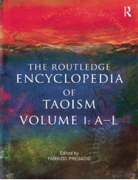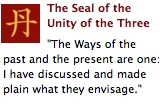Daojiao
Taoism; Taoist teaching; "Teaching(s) of the Way"
Reproduced from:
T.H. Barrett, "Daojiao"
In The Encyclopedia of Taoism, vol. 1, pp. 8-10
Edited by Fabrizio Pregadio
Routledge, 2008
The Encyclopedia of Taoism
● Table of Contents and List of Contributors
Sample Entries
● Daode jing (Scripture of the Dao and Its Virtue)
● daojia (Taoism; "Lineage[s] of the Way")
● daojiao (Taoism; Taoist teaching; "Teaching[s] of the Way")
● Daozang (Daoist Canon) and Subsidiary Compilations
● jiao (Offering)
● jindan (Golden Elixir)
● Lingbao (Numinous Treasure)
● Quanzhen (Completion of Authenticity)
● Shangqing (Highest Clarity)
● Tianshi dao (Way of the Celestial Masters)
This term, now denoting the religion which is the topic of this encyclopedia, originally meant no more than "Teaching of the Way" — though even this is misleading, in that inculcation rather than education is implied by "teaching." All early instances of the term, therefore, have a rather vague application: in preimperial times Mohists use it with reference to the classical traditions of the sages, more or less equivalent to Confucianism; from the late Han onward Buddhists use it also as an elegant synonym for fojiao, "The Teachings of the Buddha." Only in the 5th century do we find it used in the sense that it has now acquired; only then did such a term become necessary.
Up to that point various religious groups whose adherents rallied together under the new label had already come into existence, from the Celestial Masters (Tianshi dao) onward. But although they shared a common belief in the values of empire — authority and order — they remained distinct from one another, as did those individuals who adhered to traditions of ancient occult learning going back to the Han, if not earlier, which had remained outside the Han state's synthesis of learning under the banner of Confucianism. These individuals tended to use the word daojia, a term first attested in the early 2nd century BCE (Shiji, 56.2062), and used thereafter both by doxographers retrospectively describing presumed groups of texts of the preimperial period and as a term for masters of self-cultivation and the pursuit of immortality — we must suppose there was some link between early texts and contemporary masters in the Han mind.
But by the 5th century the implicit unity of all these individuals and groups over against the disparate, "uncontrolled" cults of local religion could now be replaced by a conscious unity across diversity on the model of Buddhism, where many different doctrines were accorded the same status as Buddha's word. Dynasties of the early 5th century in both the north and the south came to the conclusion that organized religion on the Buddhist model was more of a help than a threat, especially after the rebellion of Sun En and similar incidents underlined just what the results of the corruption of "higher" religion by less agreeable elements might result in. The establishment of an externally verifiable canonical literature; the codification of rituals and priestly standards in general; the beginnings of monastic foundations of the Buddhist type — all these represent the creation of a "religion" out of a much looser assemblage of religious elements, and obviously some sort of unifying name was necessary. The Yixia lun (Essay on the Barbarians and the Chinese) of Gu Huan (420/428-483/491) is usually taken as the scene of its first appearance in this sense, though its presence in the biography of Kou Qianzhi (365?-448) in the Weishu (History of the Wei; trans. Ware, "The Wei shu and the Sui shu on Taoism,"228-35) may attest a somewhat earlier occurrence, and an essay by Zhou Yong to which Gu was responding already implicitly refers to Buddhism and Taoism as contrasting jiao.
It was, of course, inevitable that the Buddhists should have attempted to disassemble this construct polemically. Uncertain of their control of physical sacred space in China, where numinous places were already cult sites, they were anxious to deny their newly organized rivals cultural space by imposing a contrast between the otherworldly concerns of Buddhism leading to nirvana, and (by analogy with the Indian case of the old Hindu gods) the sublunary status of all other religious phenomena. Laozi (☞ pictures) was acceptable as a philosopher, but had had no soteriological intent; pursuit of immortality within this world was fine (though success was, of course, dependent on karma); even some forms of religious observance might be tolerable — but not the aping of Buddhism's grand conception of the cosmos and the human condition.
This attempt at stifling daojiao at birth was frustrated by its clear political appeal as a religion much more in tune with Chinese imperial symbolism than Buddhism. On these grounds it garnered widespread support from dynasties such as the Northern Wei, the Northern Zhou and (most definitively) the Tang. During the Tang epoch the categories of the Three Teachings (of Confucius, Laozi and the Buddha) proved such a convenient way of ordering the intellectual interests of the elite — even though they were far from mutually substitutable equivalents — that at a conceptual level they became an irreducible part of Chinese culture.
The consolidation of Neo-Confucianism under Zhu Xi (1130-1200) affected discourse on daojiao in slightly different ways, as may be seen from his Recorded Sayings under this heading (Zhuzi yulei, Zhonghua shuju ed., 125.3005-6). He himself generally prefers the Han usage daojia to refer to everything from Laozi down to the religion of his contemporaries, and under that term does support the Buddhist charge of plagiarism against Taoism, mainly with a view to recapturing for Confucians elements of the state cult of Heaven which had fallen under Taoist control during the Tang. He evidently treats daojiao as a synonym for daojia, and uses it in opposition to rujiao, "Confucianism," stating that Confucianism may not be too vigorous, but Taoism has declined the most; another dictum specifies this decline (in daojia, in this case) as having taken place in two phases, from Laozi to the pursuit of immortality, and thence to the rituals and prayers which put it on a par with shamanic religion.
This rhetoric of decline, essential to the self-image of the Neo-Confucians as revivers of their Way, imposed a unity on the phenomenon known indifferently as daojia/daojiao in a completely ahistorical fashion, but a fashion that was irresistible to Protestant missionaries of the 19th century, whose religion was founded upon a somewhat analogous rhetoric with regard to Catholic Christianity. Meanwhile, Japanese scholars, under the greater traditional influence of medieval Buddhist polemics tended to bifurcate daojia, signifying the philosopher Laozi and his peers, from daojiao, signifying the religious elements opposed to Buddhism — this, too, clearly appealed to the Protestant element in Western thought. (Fukui Fumimasa, "The History of Taoist Studies in Japan and Some Related Issues," lists the key Japanese contributions to clarifying this issue; Benjamin Penny, "Meeting the Celestial Master," explores some Protestant approaches to Taoism.) Thus the manipulation of the term daojiao by non-Taoists to suit their own agendas has in no small measure created the marked 20th century confusion as to what Taoism is and was. It has at last been observed in a good discussion of the topic by Stephen R. Bokenkamp (Early Daoist Scriptures, 11), that Taoists were perfectly capable of defining themselves through their own writings. By relying on those writings this encyclopedia seeks to make clear what daojiao meant to those who appropriated this term as their own: for a complete definition, the reader is hereby cross-referred to the sum total of other entries in this volume.
T. H. BARRETT






